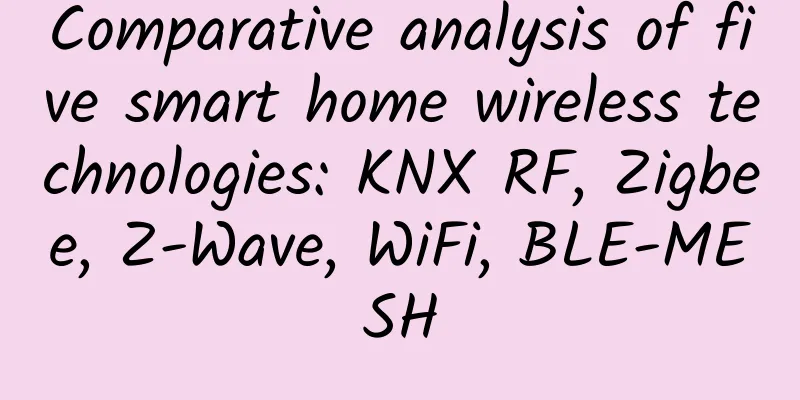Comparative analysis of five smart home wireless technologies: KNX RF, Zigbee, Z-Wave, WiFi, BLE-MESH

|
Smart home solutions need to comprehensively consider multiple factors such as technology, cost, construction convenience, and aesthetics. The traditional smart home network wiring method is a wired network, which is inconvenient to construct and affects the appearance. Manufacturers are promoting smart home solutions based on wireless technology. Wireless networks do not require wiring and will not affect the indoor appearance. They save manpower and material resources in terms of integrated wiring. They are also convenient and fast, making them very suitable for smart homes. OverviewSmart home solutions need to comprehensively consider multiple factors such as technology, cost, construction convenience, and aesthetics. The traditional smart home network wiring method is a wired network, which is inconvenient to construct and affects the appearance. Manufacturers are promoting smart home solutions based on wireless technology. Wireless networks do not require wiring and will not affect the indoor appearance. They save manpower and material resources in terms of integrated wiring. They are also convenient and fast, making them very suitable for smart homes. There are many wireless solutions for smart homes on the market, which can provide users with more choices, but also confuse users, who don't know which wireless technology to choose to build a smart home system. Although there are many wireless solutions for smart homes, the mainstream smart home wireless technologies can be summarized as: Zigbee, Z-Wave, KNX RF, WiFi, Bluetooth, etc. How to choose a smart home wireless solution? A horizontal comparison of the five major mainstream technologies. Comparison of several mainstream smart home wireless technologiesThis paper compares the above-mentioned mainstream smart home wireless technologies from several aspects, including wireless transmission technology, power consumption, number of nodes, security, openness, standardization and interoperability, industry applicability, and available software and hardware resources. 1. Wireless transmission technologyZigbee: Based on IEEE 802.15.4 standard
Z-Wave: No standard for wireless transmission technology
KNX RF: Based on EN 50090-5-3
WiFi: Based on IEEE 802.11 standards
Bluetooth: Based on IEEE 802.15 standard
2. Power consumption
3. Number of nodes
4. Security
5. Openness
6. Standardization and interoperability
7. Industry Applicability
8. Available software and hardware resources
Features Analysis1. ZigbeeThe wireless communication technology is advanced, with average anti-interference and penetration (mainly working at 2.4GHz), rich software and hardware development resources, and standardization and interoperability need to be improved. It is more suitable for applications in the smart home industry. 2. Z-WaveThe wireless communication technology is relatively advanced, with good anti-interference and penetration, single software and hardware development resources, few third-party solutions, and standardization needs to be improved, but good interoperability. It is suitable for smart home industry applications. 3. KNX RFWireless communication technology is simple but practical, with less software and hardware development resources, good anti-interference and penetration, and excellent standardization and interoperability. Wireless and wired can form a complete solution, suitable for smart home industry applications. 4. WiFiWireless communication technology is advanced, and software and hardware development resources are abundant. Anti-interference and penetration are average (mainly working at 2.4GHz). The standardization and interoperability of the smart home industry are poor. Due to high power consumption and node number restrictions, its application in the smart home industry is limited, but it has the strongest ability to integrate smart home applications into IT networks. 5. BluetoothWireless communication technology is advanced, software and hardware development resources are abundant, and anti-interference and penetration are average (mainly working at 2.4GHz). The standardization and interoperability of the smart home industry are poor. Due to the number of nodes and topology, its application in the smart home industry is limited, but it is easy to integrate into smart terminals such as mobile phones and Pads. ViewpointThe above objective comparison of several mainstream wireless technologies used in smart homes is presented above. However, when it comes to which technology a company chooses and which product a customer chooses, in addition to the comparison of technological advancement, multiple factors such as technological maturity, reliability, and engineering implementation must also be considered. Two more questions: (1) Is it necessary to support wireless technology for Mesh networks? Wireless technology that supports Mesh topology means that the wireless technology is more complex and can support more nodes and cover a wider area. However, given the complexity of Mesh topology, it will increase the difficulty of development and make network management more complex. In addition, more routes are not very meaningful in practical applications. (2) Should a pure wireless solution be adopted at this stage? Wireless technology has indeed brought a lot of convenience to smart homes, but it seems that relying solely on wireless technology cannot solve all application problems, and the reliability and stability of wireless technology still need to be improved, especially for public building applications. The wired + wireless solution is still the right choice at this stage. |
<<: Learn more about load balancers
>>: Web Hosting Guide: Ten Ways to Improve Website Performance
Recommend
How to unleash the power of the tactile internet through 5G networks
Today, the Internet is everything! It was created...
How 5G will impact data centers and how to prepare
New 5G networks are increasing connectivity betwe...
Why SD-WAN is the best way to enable digital business
In a survey of mid-market enterprises, IDC found ...
DediPath: 50% off all VPS/HybridServers, starting at $1.75 per month, multiple data centers in Los Angeles/San Jose, etc.
DediPath's spring promotion is still ongoing,...
Let’s talk about what communication is.
For many people, communication is a very general ...
What is the difference between private and public LoRaWAN networks?
[[331465]] The low-power wide-area network (LPWAN...
What is AWG? Why is AWG an important parameter when choosing cables?
When buying cables, there is an important paramet...
Private 5G and edge computing: a perfect match for manufacturing
Private 5G is the next evolution of networks for ...
With the accelerated development of 5G technology, what challenges does the data center face?
Memory security is not a new concept, but the sur...
Is your phone WLAN or WiFi? What is the relationship between the two?
I wonder if you have noticed the names of wireles...
Digital-vm New Year 50% off, KVM VPS monthly payment starts from 2 US dollars, 8 computer rooms in the United States/Japan/Singapore
I haven't shared information about Digital-vm...
Huawei Cloud Managed Campus Solution Accelerates Enterprise Digital Transformation by Saving OPEX by 87% in Three Years
[51CTO.com original article] In the digital age, ...
Edge computing and fog computing explained
By processing data at or near the source of the d...
DesiVPS: $15/year-1GB/15G NVMe/1.5TB@10Gbps/San Jose data center
DesiVPS continues the Black Friday promotion in D...
At the 2017 Asia Pacific CDN Annual Conference, Yunfan Accelerator was awarded the title of "Excellent Service Quality Enterprise"
On November 14, 2017, the 2017 Asia-Pacific CDN A...









